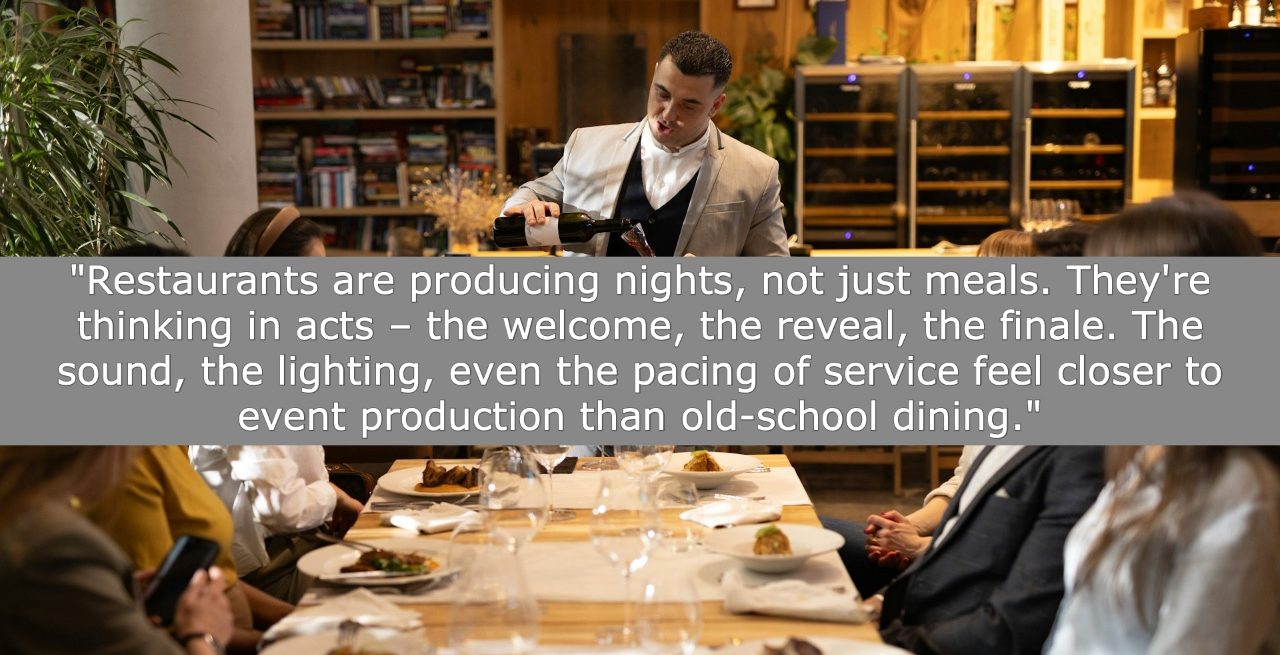Blending Cuisine with Choreography: Restaurants Borrow from Live-Event Playbooks
4 Min Read By MRM Staff
By borrowing strategies from live events, restaurant operators can design authentic dining experiences that deliver moments both memorable and shareable.
“Guests aren't just going out to eat anymore; they're going out to feel something,” said Jennifer Brisman, founder and CEO of VOW, an event-orchestration platform. She has produced more than 600 events including the Tonys, restaurant openings, and celebrity galas. “The meal is part of it, but it's the memory that matters.”
Younger generations especially value experiences and are looking for connection, creativity and immersion, she noted.
“Ten to fifteen years ago, a night out in your 20s meant bar food and a few drinks – that was considered youthful and cost-effective. Today, with the rise of social media and rising costs, young people crave meaning and beauty in how they spend their time.”
Flexible Experiential Design
Over the past decade, there’s been a major shift in how restaurants and hospitality spaces are designed, Brisman pointed out with operators thinking about group experiences and event bookings from the start. Dining areas are now built with flexible seating, movable banquettes, private areas that can open or close off, and kitchens designed to handle 200 plates in a synchronized service.
“The best restaurants in major cities have always done this, but now it's becoming standard. Modern restaurant design assumes that, at some point, the space will need to transform from everyday service to a buyout or celebration. It's no longer just about tables for two – it's about building with modularity, scalability and experience in mind.”
Producing Personalization and Shareable Moments
The hospitality industry has also started taking cues from entertainment employing lighting, pacing, storytelling elements, while entertainment borrowed hospitality's warmth and intimacy, Brisman said, adding that technology has made it possible to personalize moments at scale.
“Restaurants are producing nights, not just meals. They're thinking in acts – the welcome, the reveal, the finale. The sound, the lighting, even the pacing of service feel closer to event production than old-school dining.”
A number of restaurants are layering in interactive elements such as a chef coming to the table, a surprise course, a pop-up collaboration designed to make guests feel part of the show, she said. Others are creating tiered experiences including chef's tables or members-only nights, that function like VIP passes to create a sense of anticipation and belonging.
To create shareable experiences that resonate with guests, operators should start with authenticity, not focus solely on social media platforms like Instagram.
“If something is real – if it comes from a genuine story or emotion – it will naturally be shareable. Guests can feel when a moment was designed for them versus when it was designed for a post.”
While social media can amplify a story, but it can't invent one, Brisman explained, adding the best operators use it to extend the experience letting the night live on and engaging guests after they've gone home. She suggests using behind-the-scenes content and sharing guest posts to turn a social experience into a community one.
“It also comes down to people. A guest might forget a dish, but they'll never forget how someone made them feel. Empower your team to connect, surprise and delight. The most shareable experiences are the ones that spark emotion first and photos second.”
But operators shouldn’t try too hard because guests can spot when something feels forced or over-themed.
“Aesthetics are important, but emotion matters more,” Brisman said.
The Guest Journey Starts with Intention
A Super Bowl-sized budget isn’t necessary to think like an event producer, she said, as long as you start with intention.
“Map your guest journey – from the moment they book to when they walk out the door. Think about every sensory cue: lighting, sound, tempo, timing. And most importantly, treat every service as a live rehearsal. Great events evolve through reflection and iteration. After each night, talk about what worked and what didn't. That's how even small teams deliver big-feeling moments.”
Event-related concepts of "service design" and "guest choreography" can be used by restaurant operators to turn chaos into calm.
“The best experiences feel effortless on the surface precisely because they're carefully designed underneath. Service design is the invisible structure – how people, tools and processes work together to create ease,” Brisman said. “Guest choreography is what the guest actually feels – the rhythm of their journey, the way moments flow into one another.”
To make events seem effortless, she advises operators to never neglect their staff and to listen to guests being every reaction is data and the best experiences evolve and are never “done.” Brisman said.
“You can design the most beautiful space in the world, but if your people aren't empowered, it won't land. You plan for precision, but you train your team to pivot gracefully. Everyone knows their cues, but they're also listening, adapting and supporting each other in real time. It's a bit like a ballet: guests see beauty and flow, but backstage there's coordination, timing and trust. That's what makes something truly seamless.”
Operators can learn their guest needs by listening not just through surveys, but by paying attention to patterns, feedback and energy and being curious.
“The more you understand your guests, the easier it is to design experiences that fit like a glove,” Brisman said. “They want to feel seen. That's really it. Whether it's their name remembered, their favorite wine waiting, or sensing that someone thought about them when designing the night – it’s about personalization and care.”

